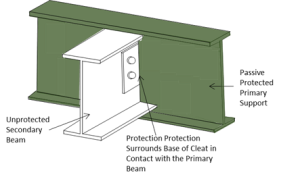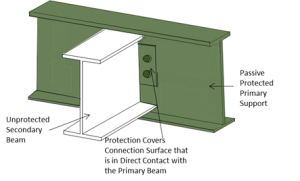Our Structural Fire Research Engineer Fanqin Meng has recently investigated how far passive protection on the primary beam needs to extend when the slab panel method is used.
When the slab panel method (SPM) design procedure is used, unprotected secondary beams are connected into protected primary beams. This raises the question as to how far the passive protection on the primary beam needs to extend over the connection and into the end of the secondary beam, in order to minimise the temperature rise in the primary beam from heat flowing in via the unprotected secondary beam.
HERA Report R4-131 gives the following recommendation in this regard for the two most commonly used secondary beam to primary beam connections; the Web Plate (WP) connection and the Flexible Endplate (FE) connection.
The effectiveness of these provisions has been investigated by heat transfer analysis through ABAQUS by Fanqin Meng and the summary of results are given below. The input fire temperature onto the steel beam components was the ISO Standard Fire Exposure for 60 minutes. This was applied to the steel surface less top flange for all unprotected components and to the outside surface of the insulation for all protected components.
Studied cases
For the Web Plate connection, three conditions were modelled:
- The web plate without any protection, so that the primary beam protection runs up to the base of the web plate. This is the recommended solution from HERA Report R4-131.
- The web plate protected.
- The web plate and the first 400mm of the secondary beam protected.
For the Angle Cleat (also covers the Flexible Endplate) connection, four conditions were modelled:
- The angle cleats unprotected over its full area including where it is bolted against the primary beam.
- The angle cleats in contact with the primary beam protected including the bolts and the protection running up to the base of the angle cleat legs bolted to the secondary beam web. This is the recommended solution from HERA Report R4-131 and is called “Half protected Angle cleat”.
- The angle cleats fully protected.
- The angle cleats and the first 400mm of the secondary beam protected.
Simulation results
The heat transfer analyses in ABAQUS were conducted to determine the effect of protection at the ends of unprotected secondary beams on the temperature distribution of connected primary beams. Two fire protection conditions are given here: (1) the web plate protected and secondary beam unprotected; (2) the web plate and the first 400mm of the secondary beam protected. The comparison results in Figure 1 indicates that applying different protection length at the ends of unprotected secondary beams produce a negligible effect on the primary beam flange temperature.
 |
 |
| (a) Primary beam flange temperature | (b) Primary beam web temperature |
Figure 1: Temperature-time curves of primary beam with different protection level on secondary beams
Discussion and conclusion
The results shown in Figure 1 indicating the bending moment capacity of primary beam is identical in above two conditions. The primary beam web temperature is 130°C hotter as against being applied also along 400mm of secondary beam. This will slightly reduce the shear capacity of the beam web at the point of secondary beam attachment; however, any reduction will be more than compensated for by the shear capacity of the concrete slab over the beam for which the contribution is currently ignored in fire engineering design and in ambient temperature design. Furthermore, for solid web beams, the shear capacity is always much greater than needed so a small loss due to localised higher temperature will not lead to premature failure. For beams with multiple unstiffened web openings, the passive protection is applied based on the web post exposure between openings, and this will generate higher temperatures than in a more robust web post that supports an incoming secondary beam which requires further investigation, so excluded from the scope of this technical note.
Thus, coat backs on secondary beams are not required when the slab panel method is used to design composite slabs under fire conditions. Figure 2 illustrated areas that require fire protection on primary beams without coat back on secondary beams. However, further investigation is required for beams with multiple unstiffened web openings.
 |
 |
| (a) WP connection | (b) FE connection |
Figure 2: passive protection on primary beams without coat back on secondary beams with (a) WP and (b) FE secondary to primary beam connections
Authors: Fanqin Meng, Charles Clifton and Kaveh Andisheh


